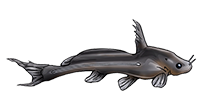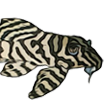/siluriformes/loricariidae/ancistrus/sp%28l309%29/1.jpg)
L309, Green Spotted Bristlenose, Grønplettet Antennesugemalle (Denmark) - Ancistrus sp. (L309)
Article © Jacqueline Bennett-Leaver, uploaded April 18, 2017.
One of the most attractive Ancistrus species would easily be Ancistrus sp. L309. For sure it is one of my favourite Ancistrus in the fish house. But with all its beauty to show it is also one of the shyest Loricariid I own. Very rarely do I see more than a tail sticking out of the cave. Even during feeding time, or when the lights turn off it doesn't show itself.
I have owned this beautiful little Ancistrus species now since 2013 and have spawned and raised many fry. The maximum size of the adults is about 8-10cm, females staying a little smaller than the males. Males are not aggressive if there are enough caves and hiding places. I keep the tank in low light, giving the fish plenty of shade. There is also a lot of wood, making sure the females can hide out of site.
I find breeding this little gem is not very difficult. Making sure their housing is perfect and the fish feel happy it only takes a few cold water changes for them to spawn. After spawning is where I find lies the more difficult task as my males always kick out the fresh egg clutch. This requires me to step in and artificially incubate the eggs to hatch into fry.
Raising the fry doesn't give any problems. The fry are put into a fry container which is placed in the main tank. It has an air lift so fresh water is circulated into the fry box. I give them some hiding places and put in a Walnut leaf which will give them the first food after their yolk sack has dissolved. Their main diet is Repashy herbivore formulas. After about three weeks I transfer the fry to the grow out tank. I found that this species is very sensitive to water conditions but with good maintenance and plenty of food the fry grow to about 3-4cm in 6 months.
In contrast to their parents, the fry are not shy and will come out to feed just for you to enjoy their beauty!
Copyright information for the images used in this article can be found on the species' full Cat-eLog page.
| Scientific Name | Ancistrus sp. (L309) |
| Common Names | L309, Green Spotted Bristlenose Grønplettet Antennesugemalle (Denmark) |
| Pronunciation | an SISS truss |
| Etymology | The name Ancistrus is derived from the Greek word agkistron, meaning hook, in reference to the interopercular odontodes that are hooked. |
| Articles | |
| Size | 90mm or 3.5" SL. Find near, nearer or same sized spp. |
| Identification | Mature males and sometimes females have soft tentacles (bushy fleshy growths) on the snout - this is unique to the genus Ancistrus. |
| Sexing | Typical for the genus with males possessing the so-called ''bushy nose''. Females also may have much smaller growths on the head but to a much lesser extent. |
| Distribution | Rio Tapajos Amazon, Lower Amazon, Tapajós (click on these areas to find other species found there) Login to view the map. |
| Temperature | 23.0-28.0°C or 73.4-82.4°F (Show species within this range) |
| Breeding | Unreported. |
| Breeding Reports | There is but a single breeding report, read it here. |
| Registered Keepers | There are 32 registered keepers, view all "my cats" data. |
| Wishlists | Love this species? Click the heart to add it to your wish list. There are 10 wishes to keep this species, see who wants what. |
| Spotters | Spotted this species somewhere? Click the binoculars! There are 17 records of this fish being seen, view them all. |
| Forum BBCode | |
| Search for A. sp. (L309) | |
| Look up A. sp. (L309) on AquaticRepublic.com | |
| LFS label creator ARN ref:1.4.4.1665 | |
| Last Update | 2021 May 11 00:53 (species record created: 2017 Apr 18 22:34) |
Back to Catfish of the Month index.




